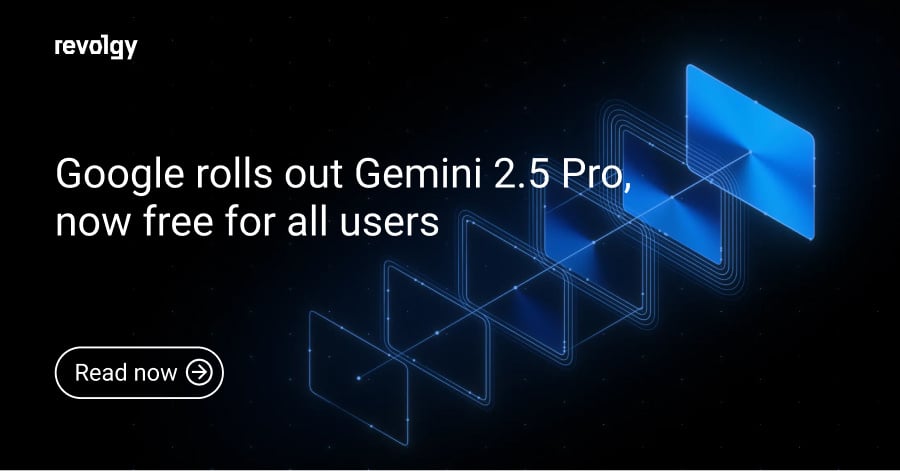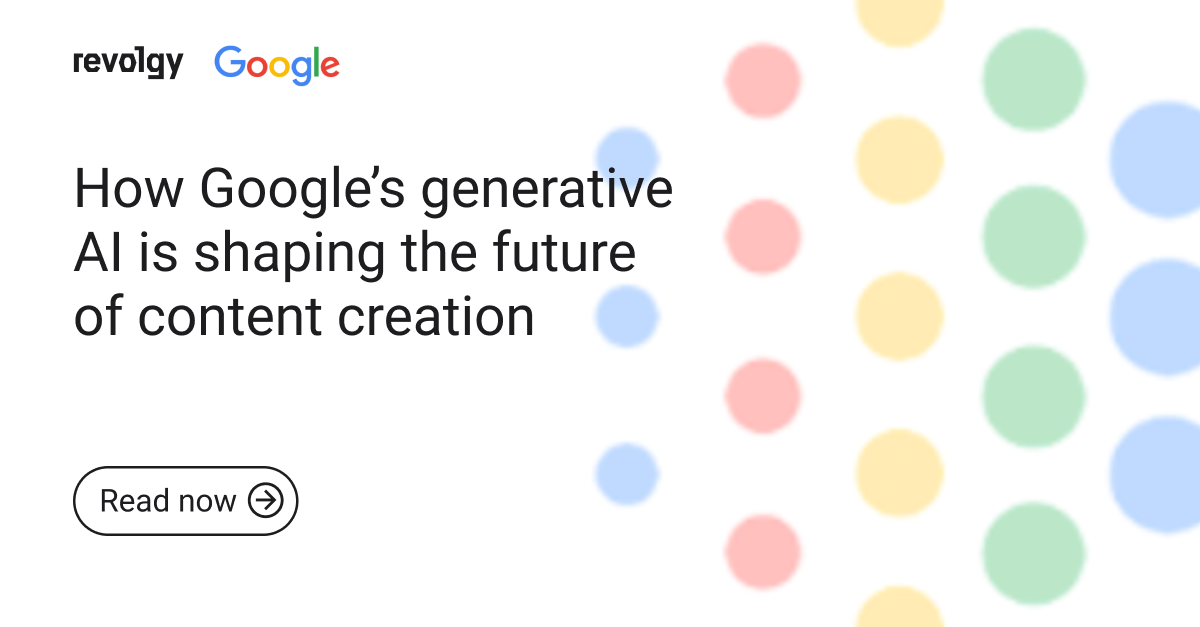Google Workspace
Moving AI from thinking to doing with Gemini 3
This week, Google announced Gemini 3 across its products.
While it is their most intelligent model yet, the real news here isn’t just about better thinking; it’s about a move toward doing.
As Google has put it, we are moving from AI that simply understands to AI that takes action:
- Gemini 1: Understanding
- Gemini 2: Thinking
- Gemini 3: ACTION
Why Gemini 3 is a big deal
It’s only been a couple of months since the last model release, which shows just how fast Google is moving here. Gemini 3 changes what developers and teams can expect from AI; we aren’t just talking about finishing lines of code anymore. This model is built to handle long, autonomous workflows where the AI acts as an agent.
To make this work, Gemini 3 introduces specific features that give developers more control and better memory,
A massive memory
Gemini 3 Pro has a context window of up to 1,048,576 tokens (1M tokens). This means you can drop in entire codebases or massive legal documents in a single prompt. This scale solves “reasoning drift”, in other words, the AI won’t lose focus or forget the original instructions halfway through a long work session.
Control its brainpower & how hard it thinks
There is a new thinking_level setting. You can turn it up to high for deep planning and complex instructions, or switch to low for quick tasks. Even on low, it keeps latency comparable to Gemini 2.5 Flash but gives you better quality answers.
It keeps its own, reliable notes
The model uses something called Thought Signatures, essentially encrypted notes the AI takes about its own logic before it acts. By passing these signatures back into the conversation history, the agent remembers its exact train of thought. This is enforced for Function Calling to stop API errors.
Most secure model yet
For enterprise teams, security is often the blocker. Gemini 3 has undergone the most comprehensive safety evaluations to date, engaging independent auditors like Apollo, Vaultis, and Dreadnode to test resistance against prompt injections and data extraction.
Adjustable media quality
Developers can balance cost and detail using the media_resolution parameter. Medium resolution is great for parsing PDF documents to save tokens; High is for analyzing fine text in images; and Low works best for general image and video descriptions to keep things fast.
What working with Gemini 3 actually looks like in practice
Gemini 3’s power comes down to three main areas: reasoning across different media, coding agents, and using tools.
1. Reasoning & multimodality
Gemini 3 is built to process information across text, images, video, audio, and code, all at the same time, changing how businesses can use their own data.
-
Healthcare: It can analyze X-rays, MRI scans, and patient history simultaneously to help doctors diagnose faster and more accurately.
-
Media & entertainment: It can automatically generate transcripts and metadata for podcasts and videos, making archives searchable.
-
Manufacturing & operations: It can watch real-time video feeds and read machine logs to predict when equipment might fail (predictive maintenance).
-
Legal & finance: It can deeply understand datasets for contract analysis with high confidence in factual accuracy.
2. Agentic coding & front-end creation
Gemini 3 stands out for its vibe-coding and agentic skills. It’s excellent at front-end development, capable of turning high-level ideas into fully interactive apps and UI components from a single prompt.
-
Teams can use this to build and test full front-end interfaces super quickly.
-
It handles complex tasks like migrating legacy code and software testing.
-
Early testing shows real results. Replit saw a level of flexibility in app creation they hadn’t seen before, and JetBrains saw a more than 50% improvement over Gemini 2.5 Pro in the number of benchmark tasks solved.
“Gemini 3 Pro truly stands out for its design capabilities, offering an unprecedented level of flexibility while creating apps. Like a skilled UI designer, it can range from well-organized wireframes to stunning high-fidelity prototypes.”
— Michele Catasta, President & Head of AI, Replit
3. Advanced tool use & planning
Because the reasoning is better, the model can handle complex, long-running tasks using large sets of tools.
-
Businesses can use it for multi-step jobs like financial planning, supply chain adjustments, and contract evaluation.
-
Complex instructions require less “prompt tuning.” Geotab, for example, reported a 30% reduction in tool-calling mistakes during complex code-generation tasks.
“Gemini 3 Pro is significantly enhancing our user experience on complex agent tasks that require multi-step planning. We immediately achieved a 10% boost in the relevancy of responses for a complex code-generation task used for data retrieval and noted a further 30% reduction in tool-calling mistakes. Ultimately this means our customers get correct answers more often, and more quickly.”
— Bob Bradley, Vice President, Data Science & AI Engineering, Geotab
How it compares to the competition
Gemini 3 Pro is putting up serious numbers, landing at the top of several independent benchmarks and challenging competitors like OpenAI’s GPT-5.1.
| Benchmark (metric) | Gemini 3 Pro (reported score) | Key insight |
| LMArena Leaderboard (Elo Score) | 1501 | Tops the leaderboard. |
| WebDev Arena (Score) | 1487 (#1 Rank) | Leading performance on web development tasks. |
| MMMU-Pro (Multimodal Understanding) | 81.0% | Leads in combining text, images, video, and audio reasoning. |
| LiveCodeBench Pro (Algorithmic Coding Elo) | 2,439 | Superior performance in competitive coding problems. |
| Terminal-Bench 2.0 (Agentic terminal coding) | 54.2% | Significantly higher ability to operate a computer via terminal (vs 32.6% for Gemini 2.5 Pro). |
The Price/Performance Advantage: While Claude Sonnet 4.5 is often considered a market leader for coding, Google is aggressively positioning Gemini 3 Pro as a more efficient alternative. In Vertex AI, Gemini 3 Pro is priced at $2 per million tokens, compared to Claude Sonnet 4.5, which is priced at $3 per million tokens.
While OpenAI’s GPT-5.1 remains very competitive (especially in coding workflows and adaptive reasoning efficiency), Gemini 3 Pro is currently leading the benchmarks, particularly for multimodal work. The 1M context window is also a clear advantage over GPT-5.1’s reported limits.
If your work involves video, screen parsing, or massive documents, Gemini 3 is the stronger choice.
How Revolgy can help
Having access to Gemini 3 is one thing; actually getting it to work safely inside your company is another. We have the deep expertise to help you securely build and run these AI capabilities on Google Cloud.
We can help by:
-
Finding use cases where it actually pays off: We don’t just add AI everywhere. We sit down with you to find the specific, expensive, or even boring problems in your business that Gemini 3 can solve immediately.
-
Developing a Strategy: We create a plan to fit Gemini 3 into your existing workflows.
-
Providing Technical Expertise: We offer support to build, deploy, and scale these solutions.
-
Making the AI understand you: We build agents that know your business and are grounded in your own private data, so they give accurate answers based on your reality, not just the internet.
Availability & getting started
Gemini 3 Pro is available today for enterprises:
-
For developers: You can start building in preview on Vertex AI. It is also available on platforms like Google Antigravity (Google’s new agentic development platform), Gemini CLI, and AI Studio.
-
For business teams: Access it via the Gemini Enterprise platform or the Gemini app for Google Workspace (select “Thinking” from the model menu).
And by the way, Google is also deploying Gemini 3 immediately into Google Search. For enterprises, this is a strong signal: if the model is fast and efficient enough to handle billions of search queries at a global scale, it is ready for your business applications.



